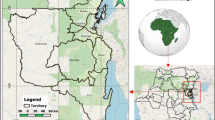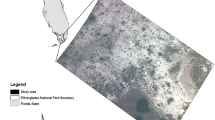Abstract
Inland freshwater lake wetlands play an important role in regional ecological balance. Hongze Lake is the fourth biggest freshwater lake in China. In the past three decades, there has been significant loss of freshwater wetlands within the lake and at the mouths of neighboring rivers, due to disturbance, primarily from human activities. The main purpose of this paper was to explore a practical technology for differentiating wetlands effectively from upland types in close proximity to them. In the paper, an integrated method, which combined per-pixel and per-field classification, was used for mapping wetlands of Hongze Lake and their neighboring upland types. Firstly, Landsat ETM+ imagery was segmented and classified by using spectral and textural features. Secondly, ETM+ spectral bands, textural features derived from ETM+ Pan imagery, relative relations between neighboring classes, shape features, and elevation were used in a decision tree classification. Thirdly, per-pixel classification results from the decision tree classifier were improved by using classification results from object-oriented classification as a context. The results show that the technology has not only overcome the salt-and-pepper effect commonly observed in the past studies, but also has improved the accuracy of identification by nearly 5%.
Similar content being viewed by others
References
Armenakis C, Leduc F, Cyr I et al., 2003. A comparative analysis of scanned maps and imagery for mapping applications. ISPRS Journal of Photogrammetry and Remote Sensing, 57(5–6): 304–314. doi: 10.1016/S0924-2716(02)00160-0
Benz U C, Hofmann P, Willhauck G et al., 2004. Multi-resolution, object-oriented fuzzy analysis of remote sensing data for GIS-ready information. ISPRS Journal of Photogrammetry and Remote Sensing, 58(3–4): 239–258. doi: 10.1016/j.isprsjprs.2003.10.002
Breiman L, Friedman J H, Olshen R A, 1984. Classification and Regression Trees. Boca Raton, FL: Chapman & Hall.
Carvalho L M T d, Clevers J G P W, Skidmore A K et al., 2004. Selection of imagery data and classifiers for mapping Brazilian semideciduous Atlantic forests. International Journal of Applied Earth Observation and Geoinformation, 5(3): 173–186. doi: 10.1016/j.jag.2004.02.002
Chu Enguo, 2001. Primary characteristics of hydrology in Hongze Lake. Hydrology, 21: 56–59. (in Chinese)
Congalton R G, 1991. A review of assessing the accuracy of classifications of remotely sensed data. Remote Sensing of Environment, 37(1): 35–46. doi: 10.1016/0034-4257(91)90048-B
Dai Honggang, Yang Zhijun, 2002. Investigation of wetland ecological condition in Hongze Lake. Environmental Science and Technology, 25(2): 37–39. ( in Chinese)
Davranche A, Lefebvre G, Poulin B, 2010. Wetland monitoring using classification trees and SPOT-5 seasonal time series. Remote Sensing of Environment, 114(3): 552–562. doi: 10.1016/j.rse.2009.10.009
DeFries R S, Chan J C W, 2000. Multiple criteria for evaluating machine learning algorithms for land cover classification from satellite data. Remote Sensing of Environment, 74(3): 503–515. doi: 10.1016/S0034-4257(00)00142-5
Friedl M A, Brodley C E, 1997. Decision tree classification of land cover from remotely sensed data. Remote Sensing of Environment, 61(3): 399–409. doi: 10.1016/S0034-4257(97)00049-7
Friedl M A, Brodley C E, Strahler A H, 1999. Maximizing land cover classification accuracies produced by decision trees at continental to global scales. IEEE Transactions on Geoscience and Remote Sensing, 37(2): 969–977. doi: 10.1109/36.752215
Gao Fangshu, Qian Yi, Wang Guoxiang, 2010. Characteristics and problems of the ecosystem in the Hongze Lake. Environmental Science & Technology, 33(5): 1–5. (in Chinese)
Haralick R M, Shanmugam K, Dinstein I, 1973. Textural features for image classification. IEEE Transaction. on Systems, Man, and Cybernetics, 3(6): 610–621. doi: 10.1109/TSMC.1973.4309314
Haralick R M, 1979. Statistical and structural approaches to texture. Proceedings of the IEEE, 67(5): 786–804. doi: 10.1109/PROC.1979.11328
Harvey K R, Hill G. J E, 2001. Vegetation mapping of a tropical freshwater swamp in the Northern Territory, Australia: A comparison of aerial photography, Landsat TM and SPOT satellite imagery. International Journal of Remote Sensing, 22(15): 2911–2925. doi: 10.1080/014311601316958416
Hu Guifang, Yang Shijian, 2004. Protection and sustainable use of the biodiversity of the westside zone of Hongzehu Lake. Yunnan Environmental Sciences, 25(2): 35–38. (in Chinese)
Huang X, Jensen J R, 1997. A machine-learning approach to automated knowledge-base building for remote sensing image analysis with GIS data. Photogrammetric Engineering and Remote Sensing, 63(10): 1185–1194.
Laba M, Blair B, Downs R et al., 2010. Use of textural measurements to map invasive wetland plants in the Hudson River National Estuarine Research Reserve with IKONOS satellite imagery. Remote Sensing of Environment, 114(4): 876–886. doi: 10.1016/j.rse.2009.12.002
Lanrence R L, Ripple W J, 2000. Fifteen years of revegetation of Mount St. Helens: A landscape-scale analysis. Ecology, 81(10): 2742–2752. doi: 10.1890/0012-9658(2000)081[2742:FYOROM]2.0.CO;2
Lawrence R L, Wright A, 2001. Rule-based classification systems using classification and regression tree (CART) analysis. Photogrammetric Engineering and Remote Sensing, 67(10): 1137–1142.
Lehner B, Döll P, 2004. Development and validation of a global database of lakes, reservoirs and wetlands. Journal of Hydrology, 296(1–4): 1–22. doi: 10.1016/j.jhydrol.2004.03.028
Liu Yongxue, Li Manchun, Mao Liang et al., 2006. Review of remotely sensed imagery classification patterns based on object-oriented image analysis. Chinese Geographical Science, 16(3): 282–288. doi: 10.1007/s11769-006-0282-0
Lu J, 1995. Ecological significance and classification of Chinese wetlands. Plant Ecology, 118(1–2): 49–56.
Mitra P, Uma Shankar B, Pal S K, 2004. Segmentation of multispectral remote sensing images using active support vector machines. Pattern Recognition Letters, 25(9): 1067–1074. doi: 10.1016/j.patrec.2004.03.004
Moore D M, Lees B G, Davey S M, 1991. A new method for predicting vegetation distributions using decision tree analysis in a geographic information system. Environmental Management, 15(1): 59–71.
Na Xiaodong, Zhang Shuqing, Zhang Huaiqing et al., 2009. Integrating TM and ancillary geographical data with classification trees for land cover classification of marsh area. Chinese Geographical Science, 19(2): 177–185. doi: 10.1007/s11769-009-0177-y
Narumalani S, Jensen J R, Althausen J D et al., 1997. Aquatic macrophyte modeling using GIS and logistic multiple regression. Photogrammetric Engineering & Remote Sensing, 63: 41–49.
Ozesmi S L, Bauer M E, 2002. Satellite remote sensing of wetlands. Wetlands Ecology and Management, 10(5): 381–402. doi: 10.1023/A:1020908432489
Pal M, Mather P M, 2003. An assessment of the effectiveness of decision tree methods for land cover classification. Remote Sensing of Environment, 86(4): 554–565. doi: 10.1016/S0034-4257(03)00132-9
Podolsky R, Conkling P, 1991. Satellite search aids wetlands visualization. GIS World, 4: 80–85.
Ruan Renzong, Feng Xuezhi, Xiao Pengfeng et al., 2005. Long term change of natural wetland of Hongze Lake. Journal of Nanjing Forestry University (Natural Sciences Edition), 29(4): 57–60. (in Chinese)
Stow D, Hamada Y, Coulter L et al., 2008. Monitoring shrubland habitat changes through object-based change identification with airborne multispectral imagery. Remote Sensing of Environment, 112(3): 1051–1061. doi: 10.1016/j.rse.2007.07.011
Stuckens J, Coppin P R, Bauer M E, 2000. Integrating contextual information with per-pixel classification for improved land cover classification. Remote Sensing of Environment, 71(3): 282–296. doi: 10.1016/S0034-4257(99)00083-8
Töyrä J, Pietroniro A, Martz L W, 2001. Multisensor hydrologic assessment of a freshwater wetland. Remote Sensing of Environment, 75(2): 162–173. doi: 10.1016/S0034-4257(00)00164-4
Töyrä J, Pietroniro A, 2005. Towards operational monitoring of a northern wetland using geomatics-based techniques. Remote Sensing of Environment, 97(2): 174–191. doi: 10.1016/j.rse.2005.03.012
Voorde T V d, Genst W D, Canters F, 2007. Improving pixel-based VHR land-cover classifications of urban areas with post-classification techniques. Photogrammetric Engineering and Remote Sensing, 73(9): 1017–1027.
Venables W N, Ripley B D, 1997. Modern Applied Statistics with S-Plus. New York: Springer-Verlag.
Wang Qing, Chen Jiyu, 1999. Formation and evolution of Hongze Lake and the Huaihe River mouth along the lake. Journal of Lake Sciences, 11(3): 237–244. (in Chinese)
Wang Sumin, Dou Hongshen, 1998. Annals of Chinese Lakes. Beijing: Science Press. (in Chinese)
Wright C, Gallant A, 2007. Improved wetland remote sensing in Yellowstone National Park using classification trees to combine TM imagery and ancillary environmental data. Remote Sensing of Environment, 107(4): 582–605. doi: 10.1016/j.rse.2006.10.019
Wang Zhiliang, Wang Guoxiang, Chang Qing, 2006. Evaluation of the wetland ecosystem of the Hongze Lake Nature Reserve in Sihong Jiangsu Province. Journal of Nanjing Normal University (Natural Science), 29(2): 115–119. (in Chinese)
Yang Shijian, 2003. Study on protection and sustainable use of wetland around Hongze Lake. Chongqing Environmental Sciences, 25(2): 15–17. (in Chinese)
Yu Q, Gong P, Clinton N et al., 2006. Object-based detailed vegetation classification with airborne high spatial resolution remote sensing imagery. Photogrammetric Engineering and Remote Sensing, 72(7): 799–811.
Author information
Authors and Affiliations
Corresponding author
Additional information
Foundation item: Under the auspices of Natural Science Foundation of Jiangsu Province (No. BK2008360), Foundamental Research Funds for the Central Universities (No. 2009B12714, 2009B11714)
Rights and permissions
About this article
Cite this article
Ruan, R., Ustin, S. Mapping of freshwater lake wetlands using object-relations and rule-based inference. Chin. Geogr. Sci. 22, 462–471 (2012). https://doi.org/10.1007/s11769-012-0521-5
Received:
Accepted:
Published:
Issue Date:
DOI: https://doi.org/10.1007/s11769-012-0521-5




